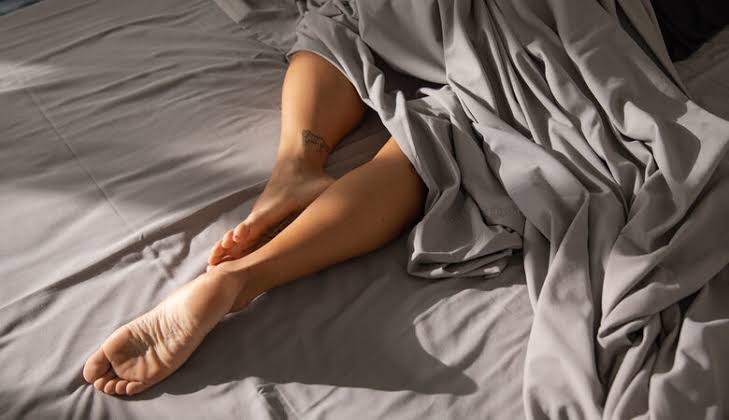Do you frequently find yourself massaging your feet on the bed in order to relax and fall asleep? We call this kind of activity “cricketing.” But to find out if it’s really beneficial for one, The Pioneer speaks with a pulmonologist, a yoga master and a sleep specialist to gain insights and provide you with a thorough examination of cricketing.
Tejal Sinha
A drooping day at work coming to an end, many find themselves doing something rather inexplicable. Without even realising, one may find themselves rubbing their feet together to fall asleep easier. According to what people discuss on the internet, this is a topic that has raised some questions.
So, let’s discuss it this week for our weekly segment of Health Talk.
It’s cricketing!
The act of rhythmically rubbing your feet together, often unconsciously, while trying to fall asleep is known as cricketing or “cricket feet.” This behaviour is named after the chirping sound crickets make when they rub their legs together. “While cricketing might seem harmless, it highlights a more significant issue: sleep disturbances caused by discomfort,” enunciates Anand Nichani, sleep expert and MD, Magniflex India. “The good news is that sleep disturbances caused by discomfort can be addressed. Many people experience sleep disturbances caused by discomfort. This can stem from various factors, such as an unsupportive mattress, improper pillows, or an unsuitable sleeping environment.”
By using technologically advanced sleep products designed to provide proper pressure point relief and spinal alignment, you can create a more comfortable sleep environment. This can lead to a significant improvement in your overall sleep quality.
Cricketing for relaxation
Dr. Pavan Yadav, Lead Consultant, Interventional Pulmonology and Lung Transplantation at Aster RV Hospital, shares that cricketing is preferred by some individuals for relaxation and sleep due to the following reasons:
Soothing sensation: The repetitive motion of rubbing feet can create a soothing, calming effect, which can help in winding down before sleep.
Stress relief: The act may serve as a form of self-soothing, reducing stress and anxiety, which are common barriers to falling asleep.
Sensory stimulation: For some people, the tactile sensation of their feet rubbing together can be comforting and can help to shift focus away from other distractions or worries, making it easier to relax.
Cricketing may help some individuals fall asleep faster by:
Inducing relaxation: The rhythmic motion can help signal to the brain that it’s time to relax and prepare for sleep.
Routine formation: If cricketing is part of a pre-sleep routine, it can serve as a cue to the body that it’s time to sleep, reinforcing a consistent sleep-wake cycle.
However, scientific evidence on the direct impact of cricketing on sleep latency (the time it takes to fall asleep) is limited. Individual experiences vary, and what works for one person may not work for another.
Possible reasons for rubbing feet together before bed
Habit: It may simply be a habitual behaviour formed over time, possibly since childhood.
Comfort seeking: Rubbing feet together can provide physical comfort and warmth, which may be conducive to sleep.
Psychological comfort: The repetitive motion may serve as a form of psychological comfort, similar to how some people might rock back and forth or fidget.
Restless Leg Syndrome (RLS): In some cases, this behaviour might be associated with Restless Leg Syndrome, a condition characterised by an uncontrollable urge to move the legs, often accompanied by uncomfortable sensations.
Cricketing, Anand says, is generally harmless unless it causes:
Pain or discomfort in the feet
Disrupts your sleep (your partner might find it distracting).
With the right sleeping environment, this enhanced comfort can significantly reduce uneasiness before sleep, allowing you to relax and fall asleep faster.
Hazards of cricketing
Generally, cricketing is harmless. However, Hansa Yogendera, Director of The Yoga Institute suggests a few considerations are:
Cricketing may cause skin irritation, leading to redness, soreness, or even blisters.
It can disturb your partner, especially if the cricketing is vigorous or if the bed is sensitive to movement.
While cricketing itself is not harmful, it can sometimes be a sign of an underlying condition such as Restless Leg Syndrome.
Does cricketing actually help?
There’s no guarantee that cricketing will make you fall asleep faster. However, Nichani shares, “If it helps you relax, it could indirectly contribute to quicker sleep onset. But make sure to sleep on a comfortable pillow and mattress made of patented memoform and massaging technology that is proven to relax you and can aid in lulling you to sleep.”
Meanwhile, Hansa further adds, “While cricketing may help some people, for others it may be ineffective. Rather than relying solely on habits like cricketing, you can consider creating a robust yogic sleep routine.”
Box
Here’s a 10-minute, five-step yogic routine by Dr. Hansraj that will help you sleep better.
First, wash your hands and feet with water and rub them dry.
Then sit on your bed and gently massage your hands, feet and face with some almond oil.
Next, sit cross-legged on your bed, slowly bend forward and touch your forehead to the mattress. Breathe calmly in baby pose for a few minutes. Bring a gentle smile to your face and say, “I am free. I don’t have to do anything. I can now rest and relax.” Smile and breathe deeper. See all your worries leak away. You’re your body and mind in your mind’s eye.
Smile as you feel light and free. Slowly straighten your back.
Then place one hand on your heart and the other on your abdomen and breathe deeply. Slowly lie down and continue this deep, relaxing belly breath and drift off into deep sleep.
While cricketing may not work for everyone, for those who do find it beneficial, it can serve as an effective tool in their sleep routine. For others, you can always try the many yogasanas and pranayamas that can lead you to blissful sleep.




